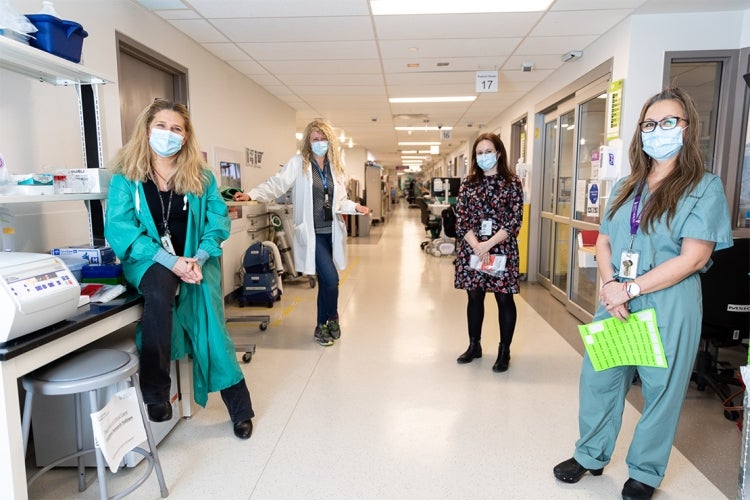Academic hospital network joins centre for research on microfluidic devices for human health

Researchers work in the Device Foundry, one of three facilities that are part of the Centre for Research and Applications in Fluidic Technologies (photo by Dahlia Katz)
Published: February 14, 2024
The Centre for Research and Applications in Fluidic Technologies (CRAFT) has expanded to formally include Unity Health Toronto, an academic hospital network and leading Canadian health research institute.
A partnership between the University of Toronto, the National Research Council of Canada (NRC) and now Unity Health Toronto, CRAFT develops leading-edge microfluidic devices – technologies that take advantage of the fundamental difference in behaviour of many fluids at the micro-scale – that can address many challenges in human health.
The latest agreement, which includes $21 million in new investments and an extension of the partnership to 2028, will support dozens of U of T trainees who will work alongside NRC scientists and engineers, as well as clinical scientists, on projects related to diagnostics bio-fabrication and organ-on-chip systems.
With the addition of Unity Health Toronto, clinicians will now join CRAFT scientists in developing new microfluidic technologies such as detection and monitoring risks of infection in intensive care unit (ICU) environments and rapid detection of arterial peripheral diseases. This will allow scientists and clinicians to directly test and validate their technologies in care settings, and develop new pathways to work with industry partners.
“CRAFT was built from the common vision that microfluidics could make a real impact on Canada’s scientific and clinical fields,” says Teodor Veres, director of R&D at the NRC’s Medical Devices Research Centre and co-director of CRAFT.
“Focused on providing new student generations with opportunities to forge ground-breaking scientific and technological advancements in microfluidic devices, these advancements have the potential to revolutionize disease diagnosis and treatment in Canada and globally. This vision was crucial to our initiative’s growth and our current success.”

Microfluidics refers to the study of fluids’ unique behaviours at the scale of microns – one thousandth of a millimetre – or smaller, as well as the design and manufacture of devices with tiny channels or other features that can precisely control these fluids. That, in turn, offers new approaches to a variety of challenges in engineering, medicine, biology and chemistry by miniaturizing, automating or innovating on established laboratory techniques.
Applications include rapid diagnostic devices that help clinicians to reliably test for the presence of certain diseases at the patient’s bedside while avoiding the cost and time delays associated with sending samples to large testing laboratories. Microfluidics are also used in biosensors that allow patients in remote communities to send accurate data to specialists located hundreds of kilometres away.
As an example, Claudia dos Santos, Unity Health critical care physician and scientist, has pinpointed a need to quickly identify ICU patients at risk of sepsis. She is working with CRAFT researchers to develop a microfluidic instrument that can detect biomarkers for sepsis on the ICU floor. Such an instrument will allow for faster diagnosis and treatment of sepsis, which can be deadly if left untreated.
“With Unity Health Toronto formally joining CRAFT, we are bringing the power and potential of microfluidic devices into clinical settings. This partnership will allow clinicians to merge their expertise with CRAFT scientists, and take the next major steps towards transforming patient care,” says dos Santos, who is an associate professor in the department of laboratory medicine and pathobiology in the Temerty Faculty of Medicine.
Another application of microfluidics, known as organ-on-a-chip, enables cells, tissues or even portions of working organs to be grown outside the body in microfluidic devices. These biological models can be used in high-throughput screening of large libraries of potentially therapeutic molecules for specific functions – for example, determining which ones would be most effective against a particular type of cancer. Such screens could even suggest the ideal therapies for an individual patient, opening the door to precision medicine.
CRAFT was founded in 2018 and includes three research and development facilities for microfluidic devices: the Tissue Foundry for bioprinting and device preclinical validation; the Device Foundry for microfluidic device design, prototyping and small-scale fabrication; and the NRC Device Fabrication and Scale-Up facility. The first two are located at U of T and available for use by academics, students, industry and government. The latter is located on the NRC campus in Boucherville, Que.
In 2023, the facilities hosted 125 unique users from across U of T as well as partner hospitals, including Sunnybrook, the Hospital for Sick Children and University Health Network. Since its inception, CRAFT has engaged 44 researchers and 114 trainees in a wide range of projects, leading to 69 peer-reviewed publications, 22 patent submissions and three spin-off companies.
“CRAFT has been a team effort all along. In addition to the NRC, we have been supported as an institutional strategic initiative through U of T’s Division of the Vice-President, Research and Innovation, and by U of T’s faculties of Engineering, Arts & Science, Medicine and Pharmacy. We all look forward to an exciting next chapter in partnering with Unity Health,” says Axel Guenther, a professor of mechanical engineering at U of T and co-director of CRAFT.
“Developing the next generation of made-in-Canada microfluidic technologies and bringing them to the people who need them most – patients, health-care professionals and pharmaceutical companies – will require strong partnerships within and outside of CRAFT, with our clinical partners, U of T’s entrepreneurship ecosystem and Canadian industry.
“We invite everyone to visit and use our open research facilities in Toronto, attend our Microfluidics Professional Course on July 17-19, or attend our research symposium in Boucherville on Oct. 12, 2024.”



